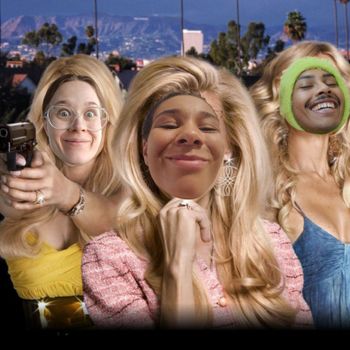Swedish Asshole is a performance dealing with audacity, provocation and power. It is a parody that explores the deprecation and inferiority complex present in Finnish society that arises from the perceived superiority of the Swedish-speaking Finns and Swedish culture. The work plays with the deciphering logics and social codes of Swedish-speaking Finns and the admiration and aspiration for the Swedish. Swedish Asshole is a hybrid of game show aesthetics in the style of “Who Wants To Be A Swedish-speaking Finn?” and Swedish Hollywood wives celebrating crayfish season (kräftskiva), which escalates to the trashing and dissolving of the (Finnish) Swedish, its meaning and social status.
The Swedish-speaking Finns as a minority are the remnants of the colonial era in Finland, when Finland was under Swedish rule. Instead of being an oppressed minority, Swedish-speaking Finns are said to be the most privileged minority in the world. It is white, rich, highly educated and as a group has a better standard of living and longer life expectancy than the rest of the Finnish population. In this work, we will perform an autopsy on the mental landscape and social climate of Swedish-speaking Finns in a scenic context - in the performance, Swedish Asshole is an antagonist who has both an inferiority complex and delusions of grandeur. The work deals with national and cultural identity, but the underlying themes are whiteness, power play, audacity, provocation and representation. We work with how identity and representation affect the art we make.
We are inspired by various cultural phenomena such as the Swedish stand-up and sketch culture, schlager and show culture as well as Swedish reality shows. The recurring motif in Swedish Asshole is three Swedish Hollywood wives, their activities, ignorance and upper class lifestyle. What is tacky - what is class? Old money vs. new money.
The work is supported by Arts Promotion Centre Finland, Finnish Cultural Foundation, Swedish Cultural Foundation, Kone foundation and Konstsamfundet.
The work was initiated by Helsinki based dance artist Johanna Karlberg and is an artistic collaboration with actor Antonia Atarah and dance artist Alen Nsambu. In addition to Karlberg, Atarah and Nsambu, the working group consists of sound designer and musician Nicolas “Leissi” Rehn, dramaturge Even Minn, scenographer Mikko Salminen, costume designer Mirjam Yeboah and lighting designer Kristian Palmu.
Johanna Karlberg (b. 1993, she/her) is a Swedish-speaking Finn dance artist based in Helsinki. Karlberg graduated from the Master programme in Dance Performance from Theatre Academy of the University of the Arts in Helsinki in 2022. She is a founding member of the art collective Lesbo Erotics. During 2025-2026 Karlberg works on an erotic lesbian DIY musical trilogy funded by the Kone foundation. Her work in general deals with social structures, identity and with how to stay open to the possibility of multiple realities and narratives simultaneously.
Antonia Atarah (b. 1996, she/her) is a Ghanian-Finnish actor and performer with a Master's degree from the Uniarts Theatre Academy acting program, along with additional musical theatre studies. Aside from her debuting and praised leading role in Ronja the Robber’s Daughter at the Swedish Theatre in Helsinki, Atarah has curiously varied between different performing art forms, practices and groups in Finland, Germany and Ghana and Tanzania. Atarah believes in collective work and aims to broaden the perception and task of "the actor" by finding diversity within that role
Alen Nsambu (b. 1998, he/they) is Finnish-Angolan choreographer and performer based in Helsinki, Finland. In 2022 they graduated from Den Danske Scenekunstskolen (DK) with a BFA degree in dance and choreography. Artistically Nsambu is busy with questions related to identity, the complexity of normal/neutral/natural, autofiction and joy (on and off stage). Using a diverse array of performative registers and representations through interdisciplinary practices is in the core of their work.
